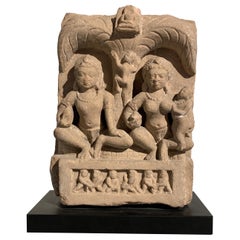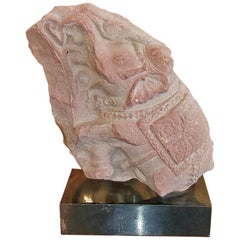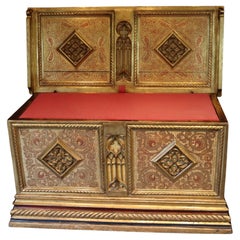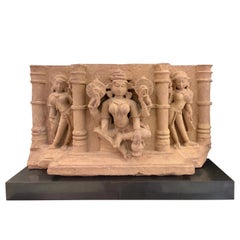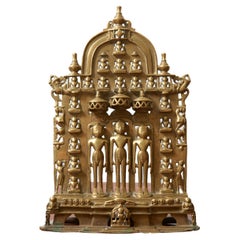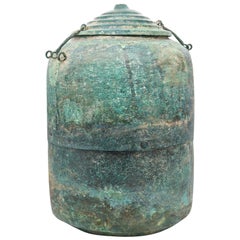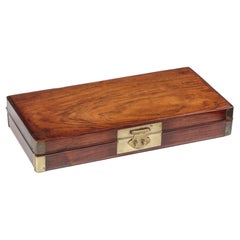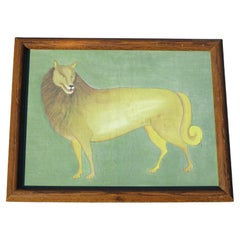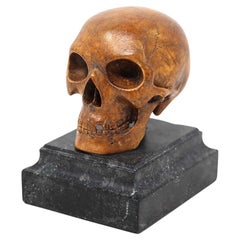Medieval Asian Art and Furniture
The Middle Ages in Europe followed the end of the Roman Empire, and in this time of change, which preceded the Renaissance, furniture was simple and utilitarian, with most homes having only the necessities like chests and benches. Much of medieval furniture, which was often made in oak or walnut, was built for the elite, particularly the emerging merchant class who owned multiple homes.
Life for many in the medieval era was unstable, and furniture was designed to be functional and portable. Peasants worked the fields for affluent landowners and didn’t have access to literature in the way that nobles and people of the church did (women less so than men). The furniture in their modest dwellings was typically limited to cookware and a handful of stools. Foldable chairs, while uncommon in homes of the early Middle Ages and emblematic of wealth, like all other furnishings of the time, allowed for easy transportation of a household. Trestle tables with detachable legs and collapsible beds were designed to be simply moved from place to place.
Medieval blanket chests were among the most important furniture objects and could further serve as tables or even beds. Some ancient traditions were carried forward to build this sturdy furniture, such as turnery. Although the furniture was minimally designed, embellishments like carvings added elegance to the heavy wood pieces. These details sometimes reflected trends in religious art like rose windows.
By the later Middle Ages, storage pieces like chests of drawers were often adorned with high relief carvings, such as geometric and floral motifs. By the 14th and 15th centuries, design had developed to include more involved pieces like cupboards and desks, while benches frequently doubled as chests with hinged seats. Beds also changed in this era from basic boards to four-post designs with large drapes to keep the sleeper warm. These beds and other medieval bedroom furniture were significant status symbols, passed down through families and used as places to conduct business and receive visitors.
Surviving examples of medieval furniture are very rare, yet its distinctive aesthetics influenced later styles like William and Mary and Arts and Crafts.
Find a collection of medieval seating, garden elements, decorative objects and other furniture on 1stDibs.
15th Century and Earlier Indian Antique Medieval Asian Art and Furniture
Sandstone
15th Century and Earlier Indian Antique Medieval Asian Art and Furniture
Sandstone
17th Century Italian Antique Medieval Asian Art and Furniture
Gold Leaf
15th Century and Earlier Indian Antique Medieval Asian Art and Furniture
Sandstone
16th Century Indian Antique Medieval Asian Art and Furniture
Bronze
15th Century and Earlier Chinese Antique Medieval Asian Art and Furniture
Bronze
15th Century and Earlier Afghan Antique Medieval Asian Art and Furniture
Stucco
16th Century Spanish Antique Medieval Asian Art and Furniture
Slate
15th Century and Earlier Chinese Antique Medieval Asian Art and Furniture
Bronze
17th Century Burmese Antique Medieval Asian Art and Furniture
Terracotta, Lacquer
15th Century and Earlier Indian Antique Medieval Asian Art and Furniture
Sandstone
15th Century and Earlier Javanese Antique Medieval Asian Art and Furniture
Stone
18th Century Chinese Antique Medieval Asian Art and Furniture
Hardwood
Late 17th Century Chinese Antique Medieval Asian Art and Furniture
Brass
19th Century Thai Antique Medieval Asian Art and Furniture
Wood
Late 19th Century Japanese Antique Medieval Asian Art and Furniture
Iron
Early 20th Century Southeast Asian Medieval Asian Art and Furniture
Wood, Paint
Late 18th Century Chinese Antique Medieval Asian Art and Furniture
Iron
Early 1900s Chinese Antique Medieval Asian Art and Furniture
Copper
15th Century and Earlier Cambodian Antique Medieval Asian Art and Furniture
Bronze
Early 20th Century Sri Lankan Medieval Asian Art and Furniture
Wood
Early 20th Century Indian Medieval Asian Art and Furniture
Cedar
Early 20th Century Asian Medieval Asian Art and Furniture
Sandstone
17th Century Japanese Antique Medieval Asian Art and Furniture
Copper, Gold
Late 19th Century Indian Antique Medieval Asian Art and Furniture
Fabric, Glass, Wood, Paint, Silk
18th Century German Antique Medieval Asian Art and Furniture
Marble
1960s Japanese Vintage Medieval Asian Art and Furniture
Metal
1970s Japanese Vintage Medieval Asian Art and Furniture
Glass, Wood, Paper
Late 19th Century Italian Antique Medieval Asian Art and Furniture
Velvet
15th Century and Earlier Indian Antique Medieval Asian Art and Furniture
Granite
17th Century English Antique Medieval Asian Art and Furniture
Iron
15th Century and Earlier Indian Antique Medieval Asian Art and Furniture
Sandstone
19th Century Antique Medieval Asian Art and Furniture
Oak
1860s English Antique Medieval Asian Art and Furniture
Metal
1860s German Antique Medieval Asian Art and Furniture
Pewter
Early 20th Century Turkish Medieval Asian Art and Furniture
Bronze, Copper, Spelter
